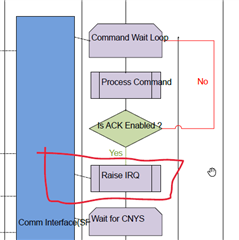Other Parts Discussed in Thread: DCA1000EVM, , , UNIFLASH
Good morning all,
I have been using the mmwaveLink layer with the IWR6843 revision D radar, with a customary 60pin (the one described in the schematics of this radar board - 60 pin-HD for DCA1000EVM). The aim is to mimic the mmwave Studio, which according to documentation, follows a mmwaveLink layer below.
My problem is that when I send a reset - I active low the lane to the radar - I do not get any response from the Interrupt lane (as seen in the MMWave Radar Interface Control manual). I have atatched the communication protocol when booting up. Am I missing something? Do I need to have the firmware downloaded to receive an interrupt when it comes to the IWR6843?
Gorka


